Design Thinking: Guide to Process, Methods & Frameworks
Published: 04 September, 2025
Innovation
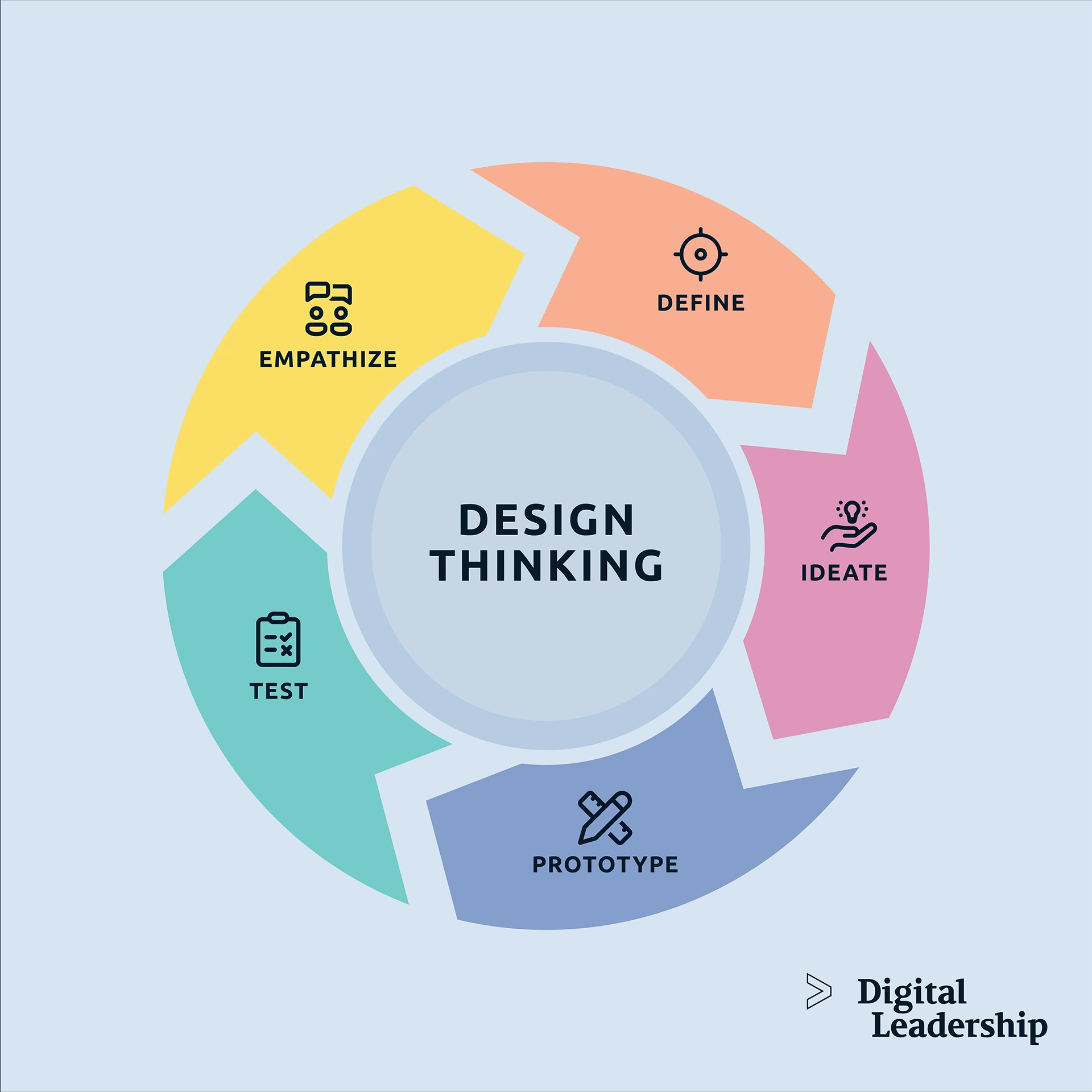
Table of Contents
People with their values and needs serve as a source of inspiration in the Design Thinking process. In this article, we explain what exactly design thinking is, what the design thinking process looks like, and what successful examples already exist.
Generating Innovation ideas doesn’t happen by accident—it happens when people, their needs, and their challenges are placed at the center of the process. That’s the power of design thinking: a practical, human-focused approach that turns complex problems into breakthrough ideas. From startups to global enterprises, design thinking has become the go-to framework for building products, services, and strategies that truly work in the real world.
In this guide, you’ll discover what design thinking is, how the process works step by step, inspiring examples from global leaders, and why it has become a must-have skill set in today’s fast-moving world. Whether you’re a business leader, UX designer, or entrepreneur, you’ll learn how to apply design thinking to spark creativity, solve real problems, and unlock innovation.
What Is Design Thinking?
Design thinking is a human-centered, iterative approach to problem-solving that focuses on understanding users, redefining problems, and developing innovative solutions. It typically follows five stages—Empathize, Define, Ideate, Prototype, and Test—and is especially effective for addressing complex or ill-defined challenges.
Design thinking is both a mindset and a methodology. It prioritizes empathy, experimentation, and user collaboration to solve problems in creative and impactful ways. As a structured process, it offers a step-by-step approach for teams to explore problems, generate ideas, and validate solutions—without relying on assumptions or linear planning.
Design thinking isn’t just a design discipline—it’s a strategic tool for innovation. Organizations that adopt it benefit from:
- Greater alignment between user needs and business goals
- Faster innovation cycles through rapid prototyping
- Increased agility in the face of change
When practiced correctly, design thinking leads to differentiation and competitive advantage by delivering more human-centered outcomes.
At its core, design thinking is about solving the right problem, not just solving a problem well.
A Human-Centered, Non-Linear Process
Unlike traditional problem-solving methods, design thinking is non-linear and iterative. Teams move back and forth between stages as they learn more from users, reframe their understanding, and refine ideas. This makes it ideal for situations where:
- The problem is unclear or unknown
- Solutions require cross-disciplinary creativity
- The context is constantly changing (e.g., tech, business, society)
Through design thinking, organizations can innovate by addressing the human needs that lie behind complex business problems.
Development and History of Design Thinking
Design thinking is a human-centered approach to innovation that focuses on solving complex problems by prioritizing user needs over technical feasibility. While it is often seen as a modern trend, its roots go back several decades.
-
Early Foundations (1990s and earlier): Researchers began exploring customer-centered approaches to innovation management.
-
Hasso Plattner’s Contribution: The SAP co-founder heavily promoted design thinking, supporting both Stanford’s d.school and Germany’s Hasso Plattner Institute (HPI) at the University of Potsdam.
-
Beyond Design: Unlike traditional methods that focus on technical solutions, design thinking places user needs and perspectives at the center of problem-solving. Practitioners adopt the user’s viewpoint to uncover meaningful and practical innovations.
In short: Design thinking has evolved into a systematic, user-driven approach to innovation, widely applied today across business, technology, education, and social problem-solving.
5 Design Thinking Process Steps: Roadmap to Innovation
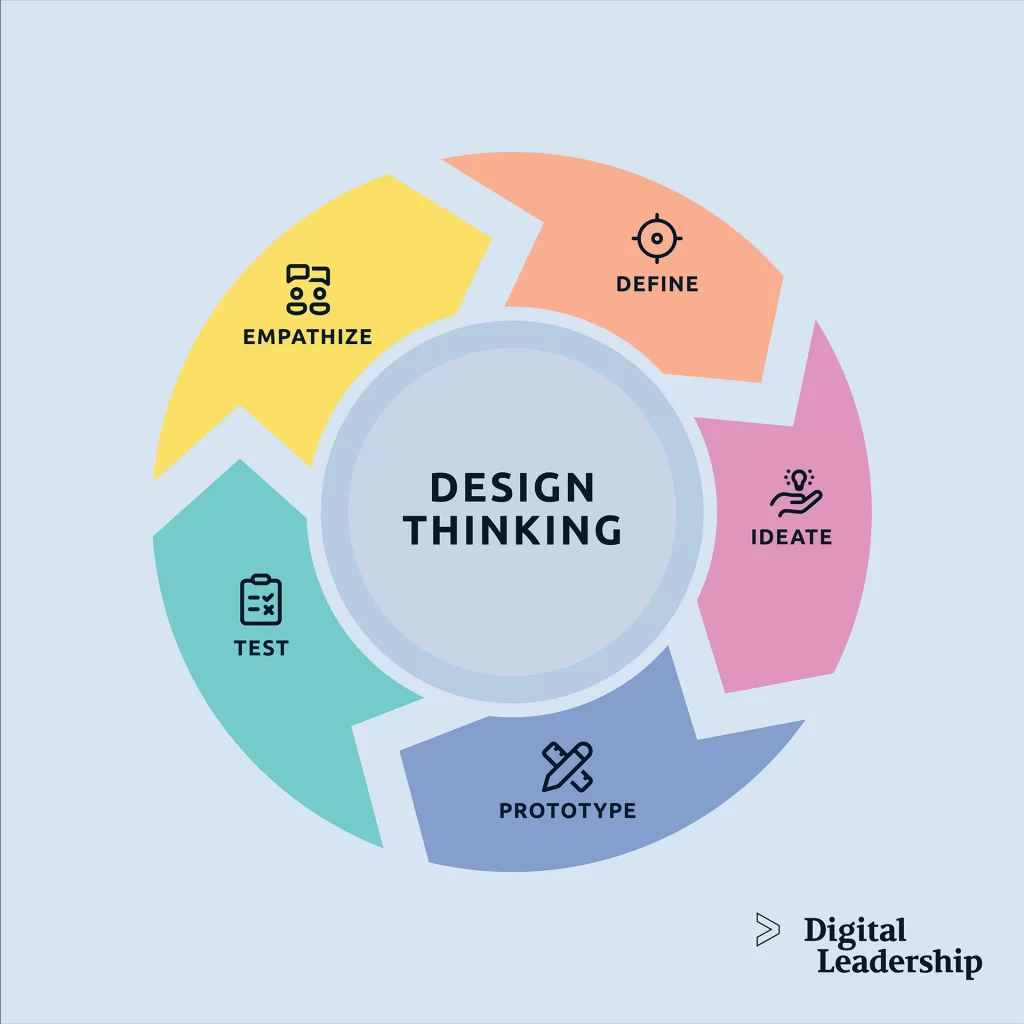
design thinking process
The five stages of design thinking are Empathize, Define, Ideate, Prototype, and Test. This non-linear, iterative process enables teams to deeply understand users, reframe challenges, generate solutions, prototype quickly, and validate ideas through real-world feedback.
Why These Five Steps Matter
Leading innovators like Apple, Amazon, and Google rely on design thinking to solve complex problems and deliver creatively compelling solutions. Innovators today can’t solve problems piece by piece—they need to think about every aspect of the design all at once.
This emphasizes that design thinking supports holistic problem solving rather than fragmented, single-focus approaches.
Stage 1 — Empathize: Research Users’ Needs
Empathy is the cornerstone of design thinking. This phase involves:
- Immersive research: interviews, observations, shadowing, and contextual inquiry
- Understanding motivations and frustrations beyond what users say
Building empathy allows designers to grasp how people will truly experience a product—not just its intended function.
Stage 2 — Define: State Users’ Needs and Problems
Here, insights from empathy are synthesized into a clear, human-centered problem statement. It’s critical that the wording centers on the user (“Customers need…”), not business goals (“Company must increase conversion”).
This phase reframes the challenge in actionable terms, serving as a guiding beacon for ideation.
Stage 3 — Ideate: Challenge Assumptions and Generate Ideas
In this creative divergence stage:
- Teams brainstorm freely, suspending judgment
- Techniques like SCAMPER, “worst idea,” and quantity-first ideation are used
- Solutions are generated widely, then refined and combined into viable concepts
Diverse, interdisciplinary teams—”T-shaped” individuals—fuel these sessions with ideas that break conventional boundaries.
Stage 4 — Prototype: Start to Create Solutions
Prototyping brings ideas into tangible form:
- Low- to high-fidelity mockups—sketches, wireframes, physical models, service blueprints
- Focused on learning rather than perfection
These early iterations reveal constraints, opportunities, and usability insights before extensive investment. The strength of the process is in rapid, iterative testing rather than delivering a polished outcome.
Stage 5 — Test: Try the Solutions Out
Testing is about validation and refinement:
- Run usability sessions with actual users
- Observe behaviors, collect feedback, and iterate designs
- Be prepared to revisit earlier stages (empathize, redefine) as needed
Design thinking isn’t over when testing ends—it’s just the beginning of refinement. And if ideas don’t work, that’s valuable learning—not failure.
Implementation — Turning Prototypes Into Impact (Bonus Stage)
Many organizations acknowledge a sixth, often overlooked phase: Implement. This involves scaling the validated solution into real-world use through pilots, rollout strategies, and storytelling to stakeholders.
Design Thinking as Three Interconnected Spaces
Instead of linear steps, design thinking can be viewed as three iterative spaces:
- Inspiration (Empathize & Define) — understanding the problem space
- Ideation (Ideate & Prototype) — exploring solutions
- Implementation (Test & Launch) — delivering impact
Teams may loop between these spaces many times to refine ideas and respond to feedback—reflecting the real complexity of innovation.
The five stages of design thinking—Empathize, Define, Ideate, Prototype, Test—offer a flexible, human-centered framework to tackle complex challenges. By iterating through these stages and incorporating implementation and systemic thinking, teams can turn insights into meaningful, impactful solutions.
For a deeper dive into design thinking and how it drives real value creation, explore our book How to Create Innovation. Inside, you’ll find practical insights on building business models, shaping strategy, and aligning purpose with innovation.
Design Thinking vs Traditional Problem-Solving
|
Traditional Approach |
Design Thinking |
|
Linear & analytical |
Iterative & exploratory |
|
Problem-focused |
User-focused |
|
Assumes requirements |
Questions assumptions |
|
Risk-averse |
Experiment-driven |
For example, rather than ask, “Why is remote productivity down?”, a design thinking approach would ask, “How might we help remote employees feel more engaged and supported?”
Why Is Design Thinking Important?
Design thinking is important because it helps organizations solve complex, ambiguous, and human-centered problems by focusing on user needs, rapid iteration, and creative collaboration. It fosters innovation, increases agility, and delivers solutions that are not only effective but relevant and meaningful.
- Solving Human-Centered Challenges: Today’s problems—whether in business, healthcare, education, or government—are interconnected and unclear. Design thinking keeps people at the center, enabling solutions that are practical, empathetic, and lasting.
- Addressing Wicked Problems: This approach thrives in complexity. It promotes action over endless analysis, iteration over perfection, and co-creation with users instead of top-down assumptions.
- Driving Innovation and Advantage: By uncovering unmet needs, accelerating prototypes, and aligning teams, design thinking improves product-market fit, reduces time to market, and builds long-term competitive strength.
- Enabling Team Collaboration: Cross-functional teams—designers, engineers, marketers, and users—work together to create inclusive solutions. This breaks silos, sparks creativity, and builds ownership.
- Used Across Industries: From healthcare to education, the public sector to business strategy, design thinking applies anywhere human experience matters. It bridges people’s needs, technology’s possibilities, and business goals.
- A Shift in Mindset: Beyond methods, design thinking is a mindset that values empathy, experimentation, iteration, and collaboration. Organizations that adopt it adapt faster and lead with greater impact.
The Goal of Design Thinking: Desirable, Feasible, and Viable
The goal of design thinking is to create solutions that are desirable (meet human needs), feasible (technically possible), and viable (economically sustainable). By balancing these three lenses, organizations can innovate with confidence and deliver real value.
Design thinking doesn’t begin with technology or digital business models—it starts with people. Unlike traditional innovation models that prioritize profitability or engineering constraints first, design thinking begins by asking: What do people actually need?
This human-first approach leads to more meaningful, impactful solutions—and when balanced with feasibility and viability, it becomes a powerful strategy for sustainable innovation.
Our UNITE Business Model Innovation framework extends design thinking beyond products and services to reimagine entire business models. Download now.

Designed by: Digital Leadership AG – Building on the 10 types of Innovation from Doblin, The SS Business Models from the University of St.Gallen & The Business Model Gallery
The UNITE Business Model Innovation Patterns
Desirability — Meet Real Human Needs
The first and most important lens is desirability: understanding what people truly want, need, and value.
- Design thinking begins with empathy—interviewing, observing, and co-creating with users
- Teams explore not just functional needs, but also emotional drivers and behaviors
- Solutions must align with the lived experience of users to gain traction
Desirability ensures your innovation is grounded in reality—not in assumptions about what users might want.”
Example: A new healthcare app might be technically impressive, but unless it fits seamlessly into the daily habits of patients and clinicians, it won’t be adopted.
Feasibility — Is It Technically Possible?
Once a solution is shown to meet a real need, the next lens is feasibility: can we build this with the technology, time, and resources available?
- Teams evaluate whether the idea is practical to implement
- They assess current capabilities, platforms, and infrastructure
- They consider how to iterate toward technical readiness over time
It’s critical not to start with feasibility, or you risk limiting innovation before it begins. Instead, explore bold ideas first, then adapt to fit constraints.
Example: A bold idea for AI-powered tutoring might not be feasible today—but with phased development, partnerships, or new hires, it could become viable.
Viability — Can It Be Profitable or Sustainable?
A solution that is desirable and feasible still must pass the viability test: can it generate revenue, savings, or impact sustainably?
- For commercial ventures, this means profitability and market fit
- For nonprofits or governments, it means mission alignment and resource efficiency
- Teams consider business models, value propositions, and long-term sustainability
Design thinking helps avoid the common trap of inventing a solution and then trying to find a market. Instead, it builds the business case around real human needs.
Example: An education tool may be desirable to students and feasible to develop, but if schools can’t afford to implement it, it’s not viable—yet.
Why Desirability Comes First
Design thinking flips the traditional innovation script.
- Traditional model: Start with what’s technically possible or financially driven, then push a solution to market.
- Design thinking: Start with what’s desirable to users, then bring in feasibility and viability.
This order ensures that teams are solving the right problems, not just building solutions that fit business goals or technical capabilities.
Why Frameworks Matter in Design Thinking
Design thinking isn’t a rigid formula—it’s a dynamic approach tailored to tackle complex, ambiguous challenges. Frameworks offer flexible scaffolding that empowers teams to:
- Navigate uncertainty
- Generate bold, user-centered ideas
- Prototype quickly and learn from failure
- Design systemically, not just symptomatically
Design thinking frameworks guide teams through structured, human-centered innovation. While methods differ, most share a common emphasis on empathy, iteration, and systems thinking to drive relevant, feasible, and lasting impact. Each framework reflects a unique way of organizing these principles to support better decision-making, faster iteration, and greater impact.
Strategic Frameworks That Support Design Thinking
Design thinking doesn’t exist in a vacuum. These strategic models complement and extend their power:
Strategy Process Map
Ideal for innovation teams and executives, this map aligns design methods with strategic decision-making:
- Define strategic challenges
- Explore options using low-fidelity experiments
- Make informed, iterative decisions
It reframes strategy as adaptive and human-centered, not static planning—crucial in volatile markets.
Iceberg Model
Designers often treat symptoms instead of root causes. The Iceberg Model reveals what’s beneath the surface:
- Events – What we see (e.g., burnout)
- Patterns – Trends over time (e.g., rising turnover)
- Structures – Policies, workflows, incentives
- Mindsets – Cultural beliefs, assumptions
By uncovering these hidden layers, teams address systemic causes rather than surface problems—designing for lasting change.
Systems Map
Complex problems require systemic thinking. Systems maps visualize how:
- Stakeholders interact
- Resources and power flow
- Feedback loops reinforce behaviors
This model helps teams see the whole, not just the parts—enabling interventions that resonate across the entire ecosystem. For example, a school redesign project might reveal gaps in principal support, leading to a new peer network that improves morale and student outcomes system-wide.
What All Frameworks Have in Common
Despite their differences, successful design thinking frameworks share core elements:
|
Principle |
Description |
|
Empathy |
A deep understanding of user needs and emotions |
|
Iteration |
Rapid cycles of testing, learning, and refining |
|
Collaboration |
Cross-functional teams with diverse expertise |
|
Systems Thinking |
Viewing problems in context, not isolation |
|
Creative Confidence |
Trusting the design process to surface bold solutions |
These shared principles ensure that frameworks remain flexible yet focused—allowing teams to adapt them for anything from startups to social innovation projects.
Design thinking frameworks aren’t about following rules—they’re about enabling possibility. Whether you’re redesigning a digital interface, rethinking healthcare delivery, or shifting corporate strategy, these models offer structure without rigidity. They help teams move confidently through ambiguity, bringing clarity, creativity, and courage to the innovation process.
Comparing Design Thinking to Other Innovation Approaches
Design thinking often complements or overlaps with other innovation models. Understanding how it aligns or differs helps apply it more effectively.
Design Thinking vs Agile
|
Aspect |
Design Thinking |
Agile |
|
Goal |
Solve the right problem |
Deliver working software fast |
|
Focus |
User empathy & ideation |
Iterative development |
|
Method |
Divergent → convergent thinking |
Incremental sprints |
|
Tools |
Empathy maps, journey maps |
Scrum, Kanban |
Design thinking helps define what to build; Agile defines how to build it.
Design Thinking vs Human-Centered Design
Design thinking is a subset of human-centered design (HCD). HCD is a broader philosophy, while design thinking provides a structured methodology to apply it.
- HCD: Philosophy of designing around human needs
- Design Thinking: Repeatable process to operationalize HCD
Design Thinking vs Lean Startup
Design thinking explores problems and ideas; Lean Startup focuses on testing assumptions and scaling.
Together, they create a powerful innovation stack:
- Use design thinking to find what’s valuable
- Use Lean Startup to validate and grow it
Design Thinking Examples And Case Studies
While design thinking may sound conceptual, its power is best understood through real-world application. The following examples illustrate how global organizations use design thinking to solve problems, innovate services, and enhance user experience.
IBM — Scaling Design Thinking Across a Global Enterprise
IBM embedded design thinking across 100+ teams and transformed its product development culture. The result?
- A 300% ROI on design-led initiatives
- Over 1,000 designers hired globally
- Creation of a unified “IBM Design Language”
IBM’s story is a blueprint for how design thinking can scale across large, complex organizations.
Airbnb — From Near Collapse to UX Innovation
In its early days, Airbnb struggled to gain traction. Their turning point? Applying design thinking to improve their user experience:
- Founders visited hosts to understand their pain points
- Reframed the platform as a hospitality company, not just tech
- Redesigned listing pages to better match real guest expectations
The result was explosive growth, showing the business power of empathy and iteration.
HelloFresh — Human-Centered Meal Design
HelloFresh used human-centered design principles (a core of design thinking) to:
- Optimize meal planning based on real customer needs
- Simplify recipe cards based on user testing
- Create packaging tailored for convenience
Design thinking helped reduce churn rates and increase customer satisfaction.
Government & Social Innovation
Design thinking is used to solve public service challenges:
- Local councils co-designing digital services with residents
- Health departments using empathy mapping to understand vaccine hesitancy
- Urban designers prototyping community-driven changes to public spaces
It empowers citizens, improves policy delivery, and fosters trust in government.
Internal Use Cases: Onboarding, Culture, Remote Work
You don’t need a product to benefit. Design thinking also transforms:
- Employee onboarding: Design user-friendly, inclusive experiences for new hires
- Remote collaboration: Prototype new workflows that work across time zones
- Culture building: Map internal friction points and co-design values
Every touchpoint in your organization is a design opportunity.
How to Implement Design Thinking in Your Organization
Design thinking isn’t just for designers. It’s a collaborative, cross-functional practice that can be applied in any business function — from HR to marketing to product development. Here’s how to get started, step by step.
Step 1 – Build a Cross-Functional Team
Start with a diverse team that includes:
- Designers or UX researchers
- Product managers
- Marketers or copywriters
- Engineers or developers
- Customer support or sales reps
The diversity of roles ensures that your ideas are grounded in multiple perspectives — a key to solving complex problems.
Step 2 – Define the Right Challenge
Poorly framed problems lead to poor solutions.
Use tools like:
- Problem framing canvas
- “How Might We…” questions
- Stakeholder interviews
A good design thinking challenge is:
✅ User-centered
✅ Actionable
✅ Not too broad or narrow
Step 3 – Conduct User Research
Use a mix of qualitative and observational research methods to understand user needs deeply:
- Interviews
- Field studies
- User journey mapping
- Empathy maps
Pro Tip: Don’t just ask what users want. Observe what they do.
Step 4 – Synthesize Insights and Define Needs
Cluster your findings into patterns. Use tools like:
- Affinity diagrams
- Persona development
- User needs statements
Step 5 – Run Ideation Workshops
Generate a wide range of ideas. Focus on quantity, not quality—at first.
Try:
- Crazy 8s sketching
- SCAMPER
- Dot voting
- Reverse brainstorming
Aim for 20+ ideas before selecting 2–3 promising ones.
Step 6 – Prototype Rapidly
Bring your best ideas to life—fast and cheap.
Depending on your context:
- Use paper wireframes
- Build clickable mockups (Figma, Adobe XD)
- Create physical models or service blueprints
Important: The goal isn’t perfection. It’s learning.
Step 7 – Test and Iterate
Put your prototype in front of real users.
- Ask open-ended questions (“What do you think this does?”)
- Observe behavior, not just feedback
- Document reactions and pain points
Then refine your prototype or pivot your approach based on insights.
The Value Proposition Canvas is the perfect complement to design thinking—connecting customer jobs, pains, and gains with your product or service features. Download now.
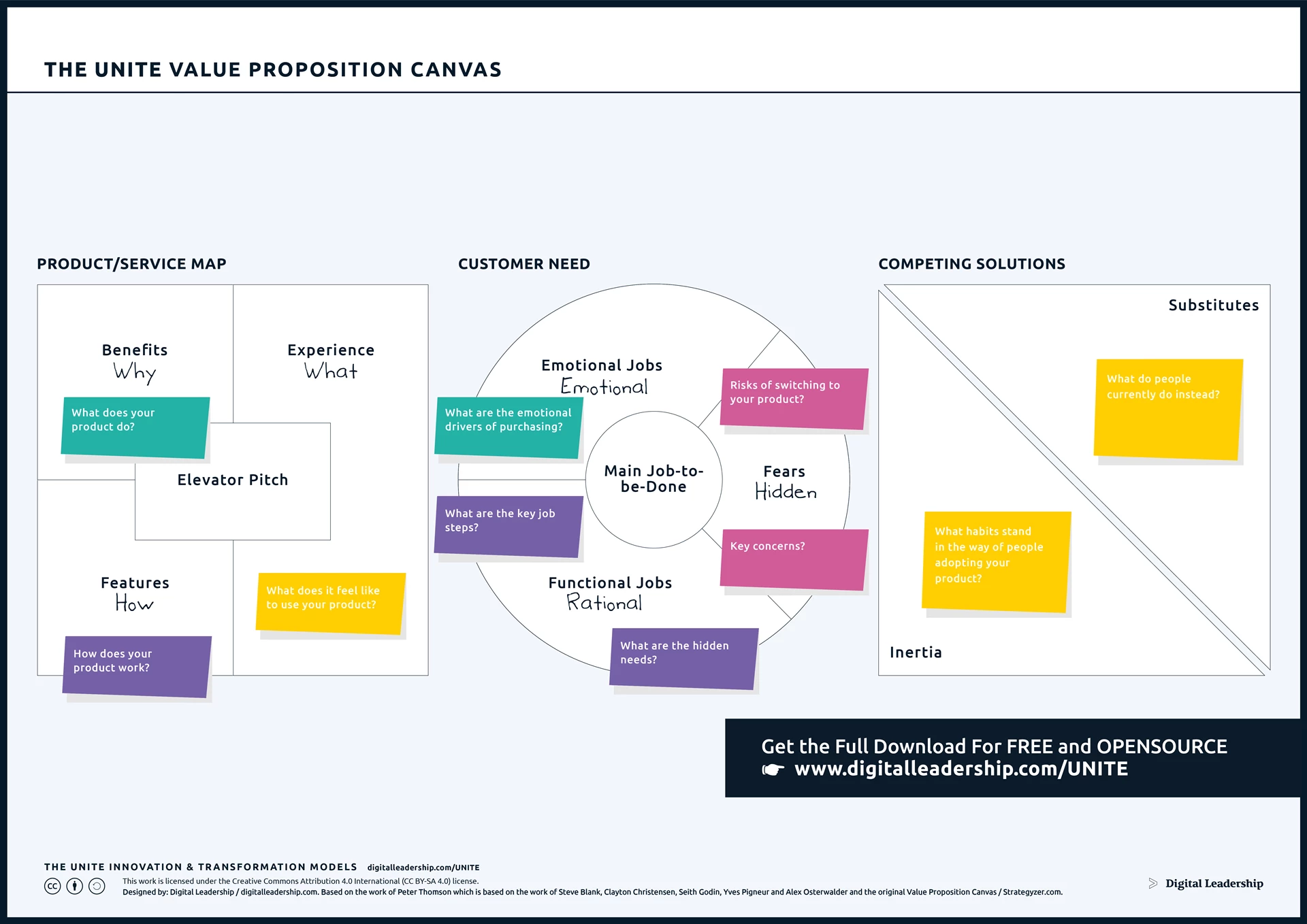
Designed by: Digital Leadership AG – Based on the work of Peter Thomson which is based on the work of Steve Blank, Clayton Christensen, Seith Godin, Yves Pigneur and Alex Osterwalder and the original Value Proposition Canvas
Step 8 – Scale, Measure, and Institutionalize
Once you’ve validated a solution:
- Build a pilot
- Track KPIs (customer satisfaction, retention, NPS)
- Train other teams in design thinking
- Embed it into team rituals and product roadmaps
Design thinking becomes a culture, not just a project.
Critical Appraisal of Design Thinking
While design thinking has become a popular framework for innovation, it is important to assess both its strengths and limitations. The method offers clear benefits, such as user-centered problem-solving and early prototyping, but it also faces challenges, including high resource demands and questions about implementation. A balanced view highlights where design thinking excels and where it requires careful management to deliver results.
Ways to Get Started with Design Thinking
Getting started with design thinking doesn’t require expensive tools or a formal process. The key is to practice curiosity, empathy, and experimentation while staying close to user needs. Here are simple ways to begin:
- Gather Insights Through Empathy and Observation: Conduct user interviews, shadowing, and real-world observations. Focus on behaviors and emotions rather than assumptions.
- Build Quick Prototypes: Start with low-fidelity sketches or paper mockups. Use early feedback to learn fast and refine ideas.
- Turn Problems Into Questions: Reframe challenges as “How Might We…” questions to spark creative exploration.
Use Research to Connect Past, Present, and Future: Map trends, contextual shifts, and user changes. Align findings with long-term vision and adaptability.
Design Thinking Characteristics
Design Thinking is defined not only by its process but also by the way teams work and the environment they use. Its core characteristics can be grouped into three areas: team, process, and space.
-
Team
-
Multidisciplinary, diverse backgrounds
-
“T-shaped” people: deep expertise + broad skills
-
Small teams (5–6) for collaboration
-
Guided by trained coaches
-
Focus on tangible, shared outcomes
-
Process
-
-
Steps: Empathize, Define, Ideate, Prototype, Test
-
User-centered at every stage
-
Divergence (explore) and convergence (focus)
-
Visualization, storytelling, rapid prototyping
-
Iterative loops for continuous improvement
-
Space
-
-
Flexible, open environments
-
Tools like whiteboards, Post-its, prototyping materials
-
Conclusion
Design thinking is a mindset and methodology for solving deeply human, complex challenges with creativity, empathy, and strategic rigor. It stands distinct from but complementary to Agile, operates through overlapping spaces of exploration and action, and draws from a rich evolution of thinkers and institutions that shaped its practice. By reframing challenges, prototyping fast, and engaging across disciplines, design thinking equips organizations to innovate meaningfully and sustainably.
Design Thinking – Frequently Asked Questions
What is design thinking in simple terms?
Design thinking is a creative problem-solving process that focuses on understanding users’ needs, generating ideas, prototyping quickly, and testing solutions. It helps you design products, services, and experiences that are both innovative and user-centric.
What are the five stages of design thinking?
- Empathize – Understand users’ needs
- Define – Frame the right problem
- Ideate – Generate creative solutions
- Prototype – Create low-fidelity models
- Test – Try solutions and iterate
Is design thinking only for designers?
No. Design thinking is used by business strategists, engineers, marketers, HR teams, educators, and social innovators. It’s a universal approach to innovation.
How is design thinking different from traditional problem-solving?
Traditional problem-solving is linear and solution-first. Design thinking is iterative, user-first, and focuses on empathy and experimentation.
What are some common tools used in design thinking?
- Empathy maps
- User journey maps
- Affinity diagrams
- Personas
- “How Might We” questions
- Prototypes (paper, digital, physical)
What is the difference between design thinking and human-centered design?
Design thinking is a methodology that puts human needs at the center. Human-centered design is a broader philosophy. Think of design thinking as the toolkit within HCD.
Can I apply design thinking to digital marketing or SEO?
Absolutely. It helps you align content with user intent, prototype landing pages, and optimize user journeys based on real behavior.
Expert Tips for Applying Design Thinking
- Start with empathy, not assumptions: Interview real users before jumping into ideas.
- Prototype faster than you’re comfortable with: Don’t aim for perfection—aim to learn.
- Test with real people, not internal teams: Internal bias kills creativity. Real feedback wins.
- Design for emotions, not just tasks: Products that connect emotionally outperform purely functional ones.
Facilitate, don’t dictate: Involve cross-functional voices in every step of the process.
The UNITE Business Model Framework: A Framework for Innovation Success
How to Create Innovation includes a number of canvases that focus on value creation and finding the right business model to meet your customer segment and customer needs. The framework is built to inspire drastic changes that help you find a competitive advantage. Our hope is that your company grows through business model innovation, and so we again encourage you to look deeper into our website and the book.
Here is a summary of the key ingredients of the Business Model Framework:

Designed By: Digital Leadership AG
Related Posts
Important But Underserved Customer Needs: How to Identify?
Creating products and services that yield more profits largely depends on understanding1
View Full articleOutcome-Driven Innovation (ODI) For Putting JTBD Theory into Action
Outcome-driven innovation (ODI) is a strategic approach that operationalizes the Jobs-to-be-Done (JTBD)1
View Full articleJobs To Be Done Examples, Theory, Framework, Templates & Statements
Remaining responsive to customer needs has become a pivotal element in driving1
View Full articleJobs to Be Done Framework: A Roadmap to Customer Satisfaction
How should you structure your business most efficiently? The best way to1
View Full article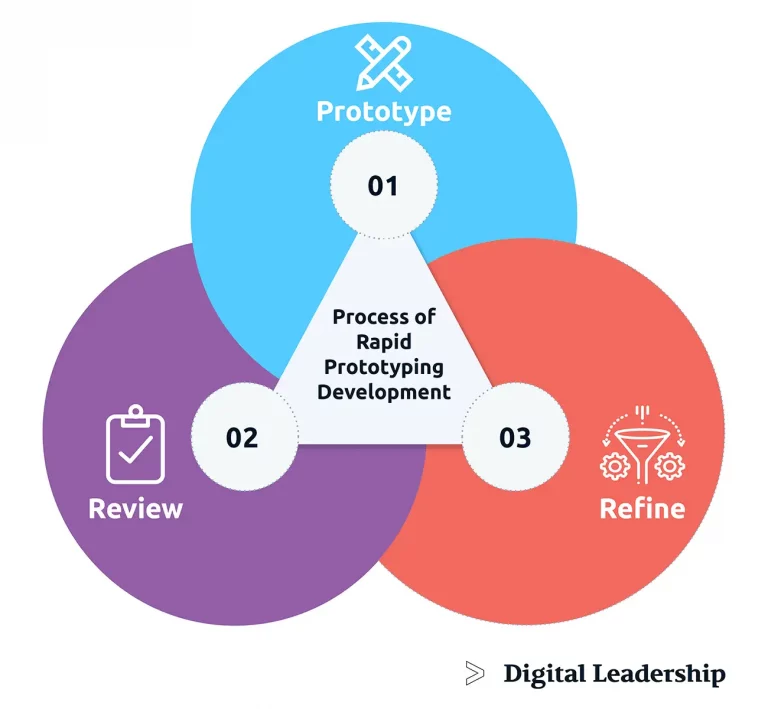















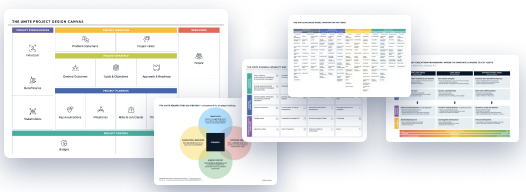











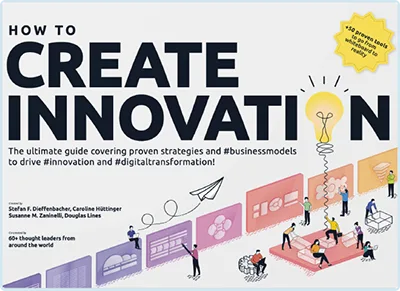 Book How to Create Innovation
Book How to Create Innovation